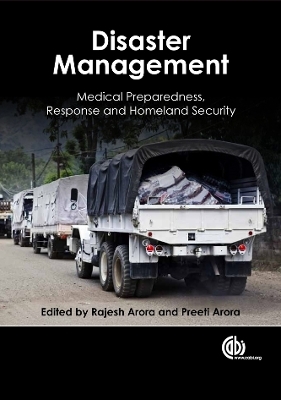
Disaster Management
CABI Publishing (Verlag)
978-1-84593-929-8 (ISBN)
Disaster management is an increasingly important subject, as effective management of both natural and manmade disasters is essential to save lives and minimize casualties. This book discusses the best practice for vital elements of disaster medicine in both developed and developing countries, including planning and preparedness of hospitals, emergency medical services, communication and IT tools for medical disaster response and psychosocial issues. It also covers the use of state-of the-art training tools, with a full section on post-disaster relief, rehabilitation and recovery.
Rajesh Arora is with the Defence Research and Development Organization, India. Preeti Arora is at the Guru Gobind Singh Indraprastha University, India.
Section 1: Disaster Management and Homeland Security: A Prologue 1: A Holistic View to Managing the Inevitable in High-tech and 3 Resource-poor Settings Section 2: Training, Mitigation and Medical Preparedness 2: The Role of the Primary Care Physician in Disasters 3: Manikin Simulation for Mass Casualty Incident Training Section 3: Crucial Role of Communication in Disaster Management and Homeland Security 4: The Role of Social Networking in Disaster Management 5: Regional Disaster Planning for Neonatal Intensive Care 6: Application of Mobile Grids for Disaster Management Section 4: Disasters and Mass Casualty Incidents: Incident Site Command and Control, Point-of-Care Testing 7: Disaster Point-of-Care Testing: Fundamental Concepts and New Technologies 8: Incident Command Systems 9: Incident Site Command and Control 10: Disasters in Medical Care Contexts: Planning for Resilience in Incident Command Personnel and Systems in Hospitals 11: Information Management during the Disaster Medical Support Planning and Execution Phases Section 5: Medical Management of Complex Disasters and MCI Victims in Hospitals 12: Potential Application of Established Pre-hospital and Hospital Synergy in Disaster Management 13: Process Management of Multiple Casualty Events Section 6: Securing the Homeland: The Medical Way 14: Suicide Bombing Response 15: Hospital Triage and Bottlenecks to the Flow of Casualties: A Review 16: Role of Military Hospitals in Handling Chemical and Biological Disasters 17: Initial Management of Mass Casualty Incidents 18: Emergency Decontamination in Low-resource Settings 19: Radiological Contaminants: Triage, Treatment and Medical Management of Exposed Persons Section 7: Defeating Emerging Health Threats: Managing by Prophylactic and Therapeutic Approaches 20: Superhumanized Antibodies for Biodefence: The Example of Anthrax 21: Medical Support in the Case of Chemical and Biological Incidents 22: Gearing up Paraphernalia for the Management of CBRN Emergencies: A Multi-stakeholder Approach is the Need of the Hour 23: Prophylactic Possibilities in Case of High Risk of Exposure to Nerve Agents Section 8: Handling Psychosocial Issues: A Difference in Perspective (Developed and Developing Nations) 24: Collective Resilience versus Collective Vulnerability after Disasters: A Social Psychological Perspective 25: Community-based Psychosocial Support: an Overview 26: Disaster Mental Health: A Paradigm Shift from Curative to Preventive Psychiatry 27: Efficient Human Resource Management Contributes to Augmented Societal Resilience in the Aftermath of Disasters:Lessons from the 2011 Tohoku Earthquake and Tsunami Section 9: Bridging the Great Divide: The Challenge of Managing Disasters and MCIs in Resource-poor Settings 28: Managing Disasters from a Health Security Perspective 29: Management of the 2011 Japan Multiple Disasters (Earthquake, Tsunami and Ensuing Disasters): A View through an International Lens 30: Viewing Mass Casualties from a Hospital Window: Relevant Issues for the Developing World Section 10: Post-disaster Relief, Rehabilitation and Recovery 31: The Immediate Post-disaster Reconstruction Phase:Alternate Care Site Settings and Vulnerable Populations 32: Management of Dead following Disasters and Mass Casualty Incidents: Critical Operational Issues Revolve around Human Resources and Logistics 33: Disaster Management: The Socioeconomic Dimension 34: Fostering Disaster-resilient Communities through Educating Children and Women for Disaster Preparedness, Response and Recovery in Developing Countries 35: Index
| Co-Autor | Mark Huntington, Dale Vincent, Marcia Trainer |
|---|---|
| Verlagsort | Wallingford |
| Sprache | englisch |
| Maße | 172 x 244 mm |
| Gewicht | 1630 g |
| Themenwelt | Medizin / Pharmazie ► Gesundheitswesen |
| Medizin / Pharmazie ► Medizinische Fachgebiete ► Notfallmedizin | |
| Studium ► Querschnittsbereiche ► Prävention / Gesundheitsförderung | |
| Sozialwissenschaften ► Pädagogik ► Sozialpädagogik | |
| Sozialwissenschaften ► Soziologie | |
| ISBN-10 | 1-84593-929-8 / 1845939298 |
| ISBN-13 | 978-1-84593-929-8 / 9781845939298 |
| Zustand | Neuware |
| Haben Sie eine Frage zum Produkt? |
aus dem Bereich


